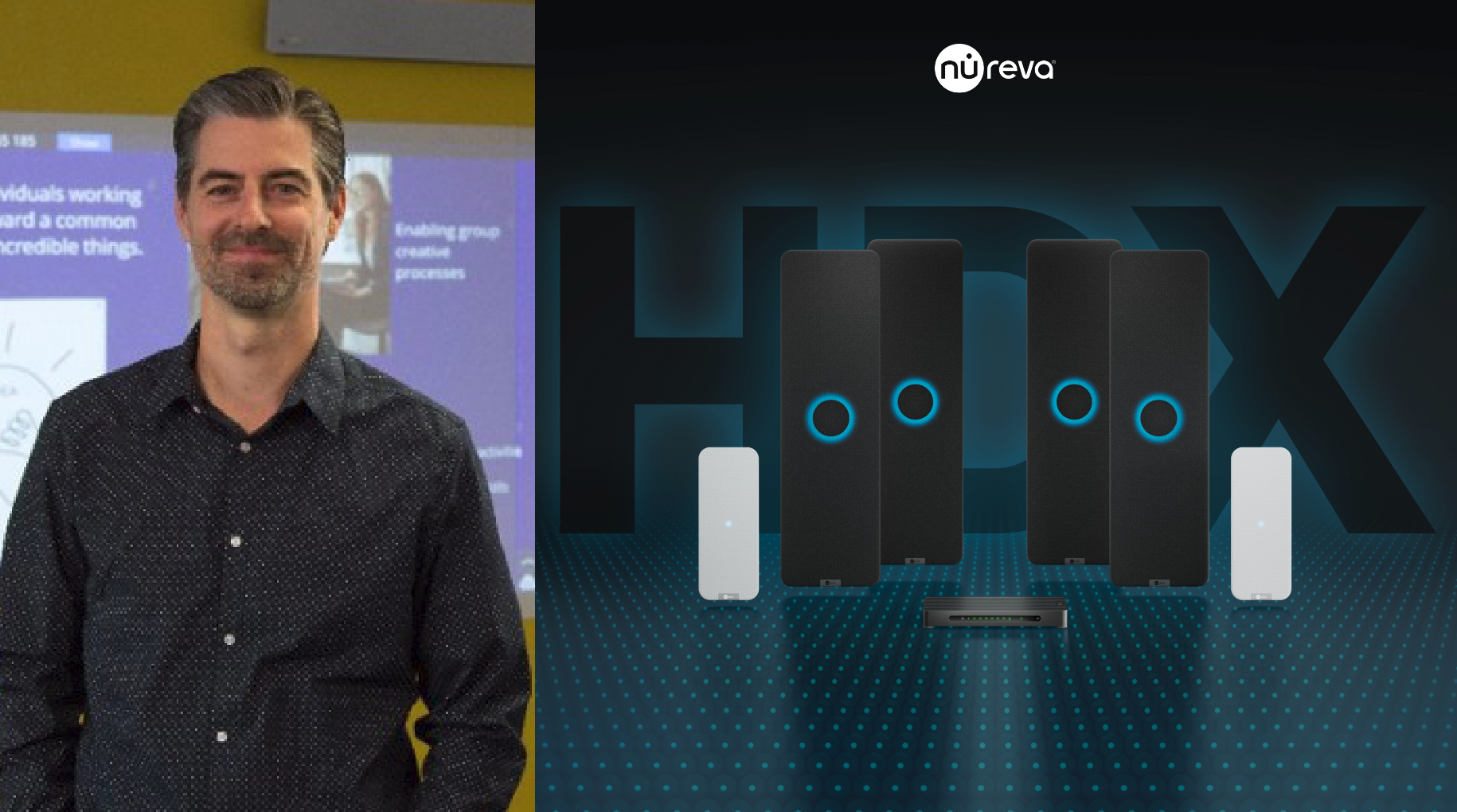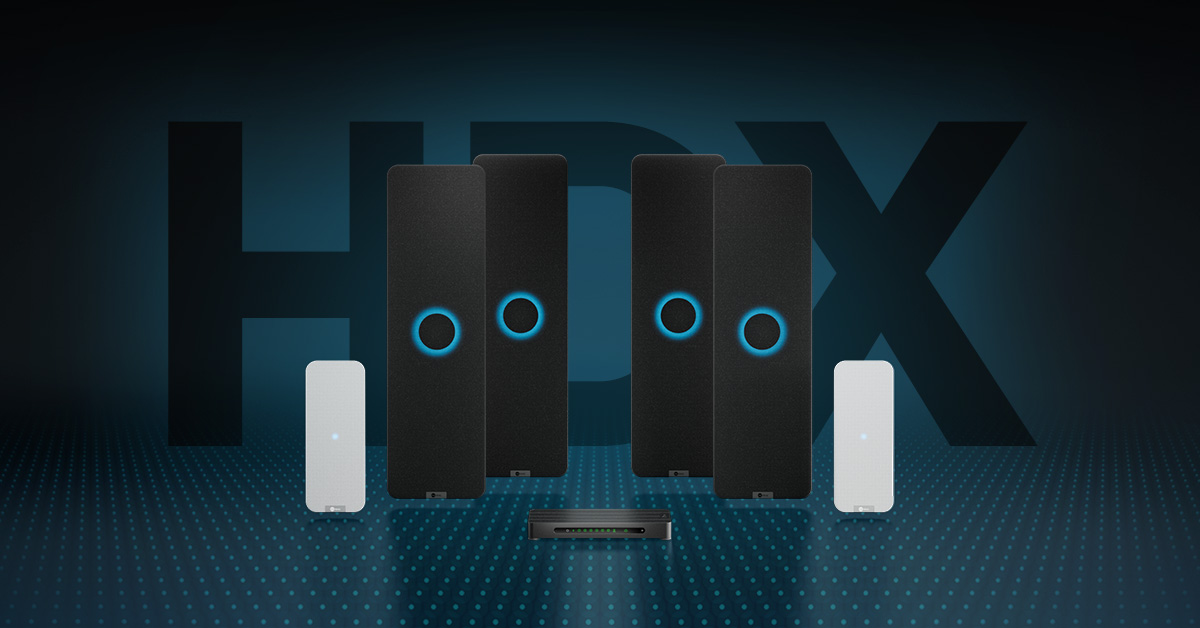In-Depth with Nureva’s EVP on the New HDX Series
Rob Abbott discusses how the HDX series addresses big-room audio, the technology behind the series, and sets expectations. Additionally, he discusses the role IT managers play in the process.

On the opening day of InfoComm 2025, Nureva is previewing its new HDX series. AV Technology’s content director, Cindy Davis, sat down with Nureva’s executive vice president of Products and Strategy, Rob Abbott, for some inside intelligence.
The full product press release is at the end of the interview.
Cindy Davis: Tell us about the HDX series and where it fits in your current lineup of products.
Rob Abbott: The HDX series is a line extension, and so we're adding it to our HDL line to broaden our portfolio. We're not taking anything away from our customers. We're providing more choices. And really, what we're doing is building on what the HDL is all about, which is great microphone coverage for conferencing use cases. We're increasingly extending our use cases into in-room use cases. And so, although the HDX does cover larger sizes, it's more about expanding into broader audio use cases, including full-range distributed speakers for amazing in-room speaker output to consume content. We are extending our full-room microphone coverage to larger spaces, improving our sound location data. We're building on adaptive voice amp by introducing adaptive voice lift. This is a brand-new area and a new set of use cases, and a really interesting area in the market as a whole, and I think a really exciting area, with the potential for users. Lastly, we're introducing Hearing Assist, which is a new area for us. And we're leveraging Auracast, which is a Bluetooth technology. We'll talk a bit more about that. But really, this is about extending our line, adding for our customers, adding choice, focusing not just on conferencing but a broader set of audio use cases, and taking our product portfolio into larger and larger spaces.
CD: While the integration channel and AV end users are critical to success, Nureva has always spoken directly to the IT audience. Why?
RA: Integrators and resellers are an important part of what we do and how we go to market. But from day one, the source of truth is the end user, and it's the decision maker. It's their problems we need to solve. It is fundamental to what we do. They give us feedback on the problems in their rooms, and it's our job to solve them creatively. So they're the source of truth. However, we also saw that our customers are increasingly taking on more responsibility for the AV in their rooms. And, of course, they want to deploy it simply. They want to manage it simply. More and more of our customers do their own evaluations and testing. From the beginning of the conversation, you're dealing directly with an IT manager, and they ask questions, wanting to know the ins and outs.
They want to try things in their own spaces; they want to set it up, and they want to experience it firsthand before making a decision. On the other side, increasingly, organizations are taking on more of the support, management, and maintenance of their rooms. They want to be in control of their own destiny. It was in our DNA to start, but it was those factors and how they wanted to buy and manage their spaces. It reinforced our commitment to continue down the path of providing tools and the right feature set for IT managers directly.
A daily selection of features, industry news, and analysis for tech managers. Sign up below.
Our product inherently lends itself to a really easy evaluation. We support our customers in doing evaluations directly. We will send them evaluation kits. And because of the way our product works, you don't have to put it in the ceiling; you can place it on a tripod in the room, and it auto-calibrates. You can experience it in your space as an end user, and it de-risks the whole thing for them, and they just know. That's another proof point of the way we've implemented big-room audio with an integrated bar with Microphone Mist. It's really easy to evaluate in your space.
CD: For those not familiar with Nureva’s Microphone Mist technology, please share how it differs from technologies in other microphone bars.
RA: The core analogy is that we take a series of physical microphones in a room and use them to create a set of virtual microphones that create a coverage map of virtual microphones throughout a space. And this is corner to corner. The whole space is filled with virtual microphones, and then using microphone missed technology, we're able to monitor and find the best sound source of speech and then apply the right audio characteristics anywhere in the room so that, unlike something that is beam forming, that has lobes, has logic that essentially has switching logic and where is the user in what lobe, let's identify it and then switch to it. What happens in that process is you get switching artifacts. You don't get uniform coverage throughout a space. You also get more dependency on tuning and calibrating the space. Microphone Mist allows us to fill a room with virtual microphones, so anyone in the space can be picked up anywhere in the room.
Because of how it works, it can continuously auto-calibrate, so you don't need to tune it. One of the things we like to say about our products is that they're really one-touch installations, and that's important for the IT managers we're talking to. You can set up the room once, and regardless of the room's layout, changes in the use case, or the number of people in the room, the product will continuously auto-calibrate and provide a great experience. You don't need to call an audio expert to tune. That's a really critical thing for us. What we've seen as we talk to people is that most large spaces now have to do many jobs. The tables and chairs are on wheels, and the space transitions from a lecture to a collaborative session every hour. This room is changing. A key theme we're considering as we bring our products to market is that these large spaces are highly dynamic. We're trying to deliver a one-touch audio system that provides full-room audio coverage and great, consistent audio pickup.
CD: Please explain the use of the terms “adaptive” and “amplification.”
RA: The reason we chose the word adaptive for voice amplification and lift is on a few levels. First, the system is adaptive to the speaker and their location, as opposed to whether they are in a specific zone or location. Again, it comes down to ease of setup and the flexibility needed in these real-world, large spaces. It's also adaptive within a lecture setting. If a lecturing instructor starts with, I want to speak; I want to be amplified through voice amplification at, say, a 20-decibel level, but at some point during this lecture, I'm going to pause and ask for questions and then I want the student to be heard at a more subtle level. We can adapt to that flow between an instructor-led to more of a Q and A, and then we can be adaptive to whether you are focused on the interim experience, or distributed student or participants. So, we can adapt to all of those flows in a lecture or a meeting in real-time without user intervention.
Lastly, we can adapt to what's happening in the room. Do you need to use voice lift? Do you need to use voice amplification? We can be adaptive to that because a room, the day in the life of a room, has many uses, and from hour to hour, it changes.
CD: Given we've been talking about the IT manager, what can they expect from the monitoring and maintenance of Nureva's products?
That's part of our ease-of-use story because it's not just ease of installation; it's ease of ownership. One of the things that we always subscribe to is to try to make it not require specialized installers to do the installation. Again, we will still go through the channel where needed. The HDX is an integrated audio bar. The cable runs are really easy. We utilize single-cable power over Ethernet.
CD: Parting thoughts?
RA: We're really excited about bringing this to market. It's a big program for us. It's early days. What we're doing at InfoComm is a preview announcement. We're telling our customers about what's coming, and because they've asked us, they need to know about things as they create standards and start to think about, "What do I need a year from now?" We're targeting our shipments to start in Q1 of 2026. We'll get some units throughout the fall, but it's important that we set the right expectations.
Nureva Previews Highly Versatile HDX Series at InfoComm

Nureva Inc., an innovator in advanced audio solutions, announces the Nureva HDX pro audio series. Each HDX configuration is a complete and flexible solution designed to meet the full range of in-room audio and remote conferencing requirements for higher education classrooms, corporate training rooms, flex spaces and large meeting rooms up to 60′ x 40′ (18.3 x 12.2 m). Building off the success of Nureva’s HDL pro series systems for audio conferencing, the HDX series is a direct response to the mounting costs and complexities faced by IT managers who need to support a growing set of in-room audio requirements beyond full-room microphone pickup. This includes high-quality in-room media playback, voice amplification, voice lift, assistive listening, lesson capture, meeting recording and support for AI agents. Traditional pro AV solutions that deliver similar functionality require trained technicians equipped with the necessary components and software for installation. In contrast, the HDX series delivers all this functionality to IT professionals in a tightly integrated, cost-effective solution that doesn’t require special expertise to install, set up or maintain. HDX systems automatically adapt to changes in room layouts and their associated audio requirements, reducing the resource load on busy IT teams and their budgets.

HDX systems come with the choice of two or four wall-mounted audio bars and one or two optional microphone pods for Adaptive Voice Lift and enhanced microphone coverage. The system hub has single-cable AV-over-IP connectivity. These components are designed to be simple to install and set up, and therefore highly scalable, and they can be configured in varying combinations depending on the room size and in-room audio requirements. HDX systems deliver full-room speaker coverage that combines distributed audio with full-range loudspeakers for exceptional in-room sound. Adaptive Voice Lift enhances voice clarity across large spaces, dynamically adjusting to the talker’s position without requiring dedicated microphones or a complex setup. Integral to every HDX configuration is Nureva’s patented Microphone Mist technology and its unique unified coverage map. The physical microphones of all the components automatically configure to create an expansive, unified microphone array to provide full-room coverage while delivering maximum gain and consistently clear audio pickup throughout large spaces. HDX systems are also compatible with AI agents such as Microsoft Copilot and Zoom’s AI Companion. Additionally, their performance is further enhanced by using trained AI models for specialized audio tasks. Voice detection AI accurately distinguishes human voices from other sounds, enhancing audio location accuracy and improving camera tracking. Noise suppression AI filters transient background noises like chair squeaks, rustling papers and slamming doors. This is an ideal complement to UC&C platforms that lack integrated noise suppression capabilities.
“Nureva continues to push the envelope by simplifying complex audio challenges in large spaces,” said Ira M. Weinstein, founder and principal analyst at Recon Research. “With the new HDX series, Nureva makes in-demand features like distributed audio and voice lift not just possible, but easy to deploy and manage.”
“With higher education institutions rapidly adopting HyFlex learning models and office environments transforming into flexible collaboration hubs, demand has surged for full-featured audio solutions that support a broad range of in-room and remote conferencing needs in larger spaces,” said Nancy Knowlton, CEO of Nureva. “Our HDX series meets this demand with an unmatched combination of simplicity and performance that helps IT professionals fully serve the needs of their users while making the best use of their resources.”
Key features of the Nureva HDX series:
High-quality in-room speakers deliver full-range audio for media playback,music, presentations, videos and recordings.
Adaptive Voice Amplification provides in-room amplification of presenter’s voice when using a wireless mic, while simultaneously maintaining full-room microphone pickup of in-room voices so everyone can be heard by remote participants.
Adaptive Voice Lift automatically boosts in-room voices across large classrooms and meeting spaces, without the use of wireless microphones. When one or two HDX microphone pods are included, the audio bars automatically configure to deliver maximum gain, ensuring clear communication everywhere in the space.
Advanced conferencing audio guarantees full-room microphone coverage, ensuring clarity for remote participants.
Audio recording capabilities seamlessly integrate in-room microphones, wireless microphones and external audio sources, making high-quality lecture and meeting capture effortless.
Assistive listening is simplified with built-in Auracast broadcast technology, ensuring easy accessibility for those who are hard of hearing.
Simple installation and scalability
Two or four audio bars easily mount on walls and an optional one or two microphone pods easily mount on walls or ceiling T-bar rails, with single-cable connections to the system hub.
A user-friendly configurator tool streamlines the component selection, setup and deployment process, eliminating the need for external technical support.
The Nureva acoustic check tool, available with the iOS version of the Nureva App, measures background noise and reverberation, providing a clear score of room acoustics and guidance on optimal placement of the audio bars.
Sustainably designed using energy-efficient sleep modes, passive cooling and environmentally responsible materials such as 30% post-consumer recycled plastics and 95% recycled fabrics. The HDX series also features eco-conscious packaging made from 99% recyclable materials, replacing hard-to-recycle foam inserts with biodegradable molded pulp. Packaging dimensions are optimized to reduce waste, improve palletization and help lower transportation emissions.
HDX systems will be available to order in October 2025 and will ship in early February 2026.

Cindy Davis is the brand and content director of AV Technology (AVT). She was a critical member of the AVT editorial team when the title won the “Best Media Brand” laurel in the 2018 SIIA Jesse H. Neal Awards. Davis moderates several monthly AV/IT roundtables and enjoys facilitating and engaging in deeper conversations about the complex topics shaping the ever-evolving AV/IT industry. She explores the ethos of collaboration, hybrid workplaces, experiential spaces, and artificial intelligence to share with readers. Previously, she developed the TechDecisions brand of content sites for EH Publishing, named one of the “10 Great Business Media Websites” by B2B Media Business magazine. For more than 25 years, Davis has developed and delivered multiplatform content for AV/IT B2B and consumer electronics B2C publications, associations, and companies. A lifelong New Englander, Davis makes time for coastal hikes with her husband, Gary, and their Vizsla rescue, Dixie, sailing on one of Gloucester’s great schooners and sampling local IPAs. Connect with her on LinkedIn.
